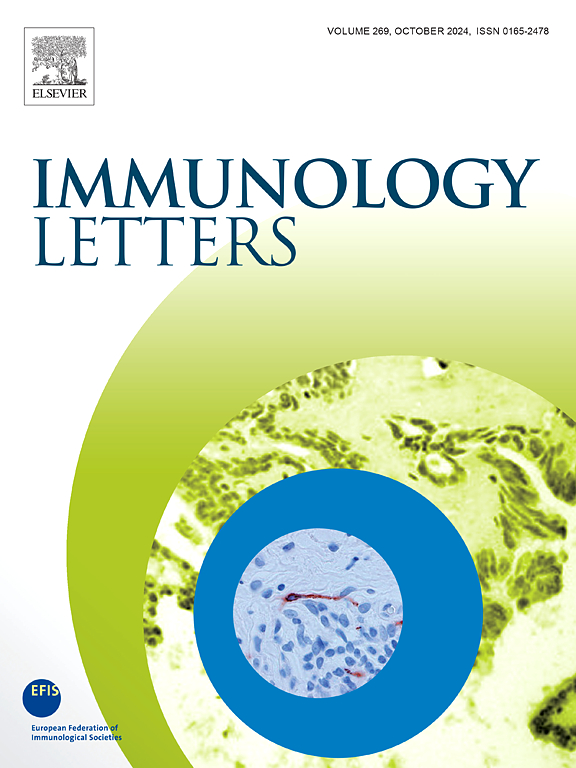严重COVID-19疾病期间细胞对SARS-CoV-2反应的协调
IF 2.8
4区 医学
Q3 IMMUNOLOGY
引用次数: 0
摘要
对SARS-CoV-2的早期细胞和体液免疫反应导致COVID-19疾病严重程度的广泛变化。在这里,我们对17名因严重COVID-19住院的患者在首次出现症状后中位31天内对SARS-CoV-2的这三个免疫反应进行了观察性研究。我们发现,主要的T细胞反应是针对刺突病毒蛋白的两个特定区域,称为B和E,它们与NK细胞上KIR2DL1抑制受体的表达呈负相关(p=0.03和p=0.0001)。此外,NK细胞上抑制受体ILT2的表达仅与T细胞对特定E区的反应相关(p=0.02),提示HLA-G可能在NK对T细胞反应的消除中起作用。此外,抗体反应主要针对核衣壳,而抗体中和反应与细胞对spike的反应呈负相关(p本文章由计算机程序翻译,如有差异,请以英文原文为准。
Coordination of cellular responses to SARS-CoV-2 during severe COVID-19 illness
The early cellular and humoral immune responses to SARS-CoV-2 result in a wide range of COVID-19 disease severity. Here we conducted an observational study of these three arms of the immune responses (T, B and NK) to SARS-CoV-2 in 17 patients hospitalized for severe COVID-19 at median of 31 days after first symptoms. We found that the main T cell response was directed against two specific regions of the spike viral protein, called B and E, which are inversely correlated with the expression of the KIR2DL1 inhibitory receptor on NK cells (p = 0.03, and p = 0.0001 respectively). Furthermore, expression of the inhibitory receptor ILT2 on NK cells was only correlated with T cell responses against the specific E region (p = 0.02), suggesting that HLA-G may play a role in the extinction of the NK response to the T cell response. Moreover, the antibody response was mainly directed against the nucleocapsid, whereas the antibody neutralizing response was inversely correlated with the cellular response to spike (p < 0.003). Taken together these data suggest a strong coordination between the innate and adaptive immune responses during the acute phase of infection, which could reflect the further resolution of COVID-19 patients with severe disease.
求助全文
通过发布文献求助,成功后即可免费获取论文全文。
去求助
来源期刊

Immunology letters
医学-免疫学
CiteScore
7.60
自引率
0.00%
发文量
86
审稿时长
44 days
期刊介绍:
Immunology Letters provides a vehicle for the speedy publication of experimental papers, (mini)Reviews and Letters to the Editor addressing all aspects of molecular and cellular immunology. The essential criteria for publication will be clarity, experimental soundness and novelty. Results contradictory to current accepted thinking or ideas divergent from actual dogmas will be considered for publication provided that they are based on solid experimental findings.
Preference will be given to papers of immediate importance to other investigators, either by their experimental data, new ideas or new methodology. Scientific correspondence to the Editor-in-Chief related to the published papers may also be accepted provided that they are short and scientifically relevant to the papers mentioned, in order to provide a continuing forum for discussion.
 求助内容:
求助内容: 应助结果提醒方式:
应助结果提醒方式:


